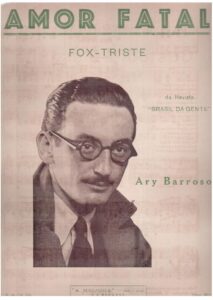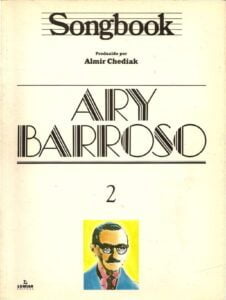Come join us now, and enjoy playing your beloved music and browse through great scores of every level and styles!
Can’t find the songbook you’re looking for? Please, email us at: sheetmusiclibrarypdf@gmail.com We’d like to help you!
Table of Contents
Who was Ary Barroso (1903-1964)?
Birth – Death: 11/07/1903 – 02/09/1964
Musical Style: Samba

Contents List download:
Ary Evangelista Barroso, Ary Barroso, was born in Ubá (Minas Gerais) on November 7, 1903. His father, Dr. João Evangelista Barroso, was a state deputy and public promoter in Ubá. After the death of his mother, Dona Evangelina, and his father (both in 1911), he was adopted by his aunts Dona Gabriela and Dona Rita, the latter a piano teacher and responsible for his introduction to music.
Best Sheet Music download from our Library.
At the age of 12, despite his aunts’ efforts to make him a father, he began working as an assistant pianist at Cinema Ideal, in Ubá. He initially studied at the Guido Solero public school. After going through several schools in the Mata area, the course concluded at the Ginásio de Cataguases. He composed the cateretê “De longe” at the age of 15 and then the march “Ubaenses gloriosos”. In 1992, with the death of his aunt Sabino Barroso, former Minister of Fazenda, he received an inheritance of 40 contos, which made it easier for him to go to Rio de Janeiro to study.

In 1921, he entered the Faculty of Law, in Ruda do Catate, at the same time going to frequent the bohemian bars of the capital. In 1922, failing college and already without money, he began to work as a pianist at the Cinema Íris, in Largo da Carioca. In May 1923 he began to play with maestro Sebastião Cirino’s orchestra in the waiting room of the Carlos Gomes Theater. He also performed in Alarico Pais Leme’s orchestra, at the Trianon Theater, and in J. Tomás’ orchestra, in the waiting room of the Eldorado Cinema.
He later played in dance orchestras, such as American Jazz, led by maestro José Rodrigues, and in the Jazz Band Sul-Americana, led by Romeu Silva. In 1926 he resumed his law studies without abandoning his activities as a pianist, until Maestro Spina, from São Paulo, invited him to go on an excursion with him to Poços de Caldas (Minas Gerais). During the eight months of travel he produced several compositions. Returning to Rio de Janeiro, in 1929, he gave Djalma de Vincenzi, manager of Carlos Wehrs, some compositions, among which “Pobre e esfarrapada”, “Pente Fino” and “É tumba, oi”, which were shown to Luís Peixoto and Olegário Mariano, then reviewers of the Teatro Recreio, in Rio de Janeiro.
Please, subscribe to our Library.
If you are already a subscriber, please, check our NEW SCORES’ page every month for new sheet music. THANK YOU!
Thus began his participation in musical theater, which extended from 1929 to 1960, having written music for more than 60 theatrical pieces. On April 25, 1929, the magazine Laranja da China, by Olegário Mariano and Luís Peixoto (music in partnership with Júlio Cristóbal and Sá Pereira), premiered at the Teatro Recreio. Among the sambas included were “Vou à Penha”, sung by Zaíra Cavalcanti (which marked her debut on record, recorded by her faculty colleague Mário Reis at the Odeon, in 1929), and “Vamos deixar de intimacies”, her first hit. , also recorded by Mário Reis and performed in a show by Araci Cortes. In that year he completed his law course.
Encouraged by Eduardo Souto, he entered the marchinha “Dá nela” in the Casa Edison carnival music contest for the 1930 Carnival. The music won first place, and on January 18, 1930, he received the prize of five contos in the Lyric Theater, which allowed him to marry Ivone Belfort Arantes. He then continued to Belo Horizonte (Minas Gerais) where his uncle, state representative Inácio Barroso, got him appointed municipal judge of Nova Resende (Minas Gerais).

Ary Barroso decided, meanwhile, not to accept the appointment and then returned to Rio de Janeiro, ready to become a professional musician. In 1931 he produced several compositions for musical theater, highlighting “Faceira”, launched by Sílvio Caldas in the magazine “Brasil do amor” (in partnership with Marques Porto), which premiered it in May at the Teatro Recreio. In June, the magazine “É do balacobaco” (by Vítor Pujol and Marques Porto) was brought to the stage at the same theater, which included, among others, their music “Na grota funda”, with lyrics by the caricaturist J. Carlos. At the premiere was the composer Lamartine Babo, who was impressed with the music and decided to write other lyrics for the melody.
Thus was born “No rancho fundo”, released days later on the program that Lamartine commanded on Rádio Educadora, in Rio de Janeiro, and which would mark the beginning of a partnership responsible, among others, for the compositions “Palmeira triste”, “Na virada da montanha” and “Grau dez”.
His prestige as a composer was assured between 1931 and 1933. In addition to his intense participation in the theater, he had a considerable number of compositions recorded by Sílvio Caldas, Carmen Miranda, Elisinha Coelho, by the duo Jonjoca and Castro Barbosa and others. He entered radio appearing on the program “Horas do Outro Mundo”, by Renato Murce, and then on the “Programa Casé”, both on Radio Philips, in Rio de Janeiro.
In 1934, after having gone to Bahia as a pianist with the Napoleão Tavares Orchestra, he created the program “Hora H” on Radio Cosmos (in São Paulo), which in 1935 would also be launched on Radio Cruzeiro do Sul, in Rio. of Janeiro. Even in 1935 he made his debut as a sports announcer, assisting Gagliano Neto in broadcasting car races on the Gávea circuit.
As a soccer announcer, he became famous for playing a flute funnily every time a goal was scored, and for his bias in favor of the Flamengo soccer team. Without stopping composing, in 1937 he launched the program “Calouros em Desfile” on Radio Cruzeiro do Sul (which would later be transposed to TV Tupi). In it, he required that the candidates sing only Brazilian music and that they correctly announce the names of the composers. When he transferred to Radio Tupi in 1938, he began to act as a commentator, comedian, actor and announcer.

In June 1939, Ary Barroso launched, in the musical magazine “Entra na faixa”, at the Teatro Recreio, the samba “Aquarela do Brasil”, sung by Aracy Cortês. Performed the following month by Cândido Botelho in the show “Joujoux et Balangandans”, by Henrique Pongetti (music in partnership with Lamartine Babo and Nássara), at the Teatro Municipal, and recorded in August by Francisco Alves, at the Odeon, “Aquarela do Brasil” was the initiator of samba-exaltação, with an extensive melody and always supported by great orchestration – a genre that was credited as destined to conquer the international popular music market.
The most famous of his compositions had hundreds of recordings in Brazil and abroad. In 1944, he made two trips to the United States, after the launch in the North American market of “No tabuleiro da baiana” and “Aquarela do Brasil”. He then composed “Rio de Janeiro”, for the film “Brazil” (1944), by Republic Pictures, recorded in 1950 by Dalva de Oliveira at the Odeon, and which was nominated for the Oscar for best soundtrack music. He also contributed to the soundtrack of the film “Você já foi à Bahia?”, by Walt Disney.
On the second trip, he scored the film “Três garotas de azul”, which remained unfinished. Due to lack of favorable conditions for a greater impact of his work, he gave up settling in the United States, a country to which he would return in 1945 to score, in New York, the show “O throne das Amazonas”, which would contain 18 of his compositions, which was never brought to the stage because he died shortly before the premiere.
In 1946, he was the second most voted candidate of the National Democratic Union (UDN) in the elections for the chamber of deputies of Rio de Janeiro, then the Federal District, and a great defender of the construction of the Maracanã Stadium. He actively participated in the field of copyright collection, as a member of the UBC (and as its first president, in 1942), of the SBAT and SBACEM.
In 1953, he organized the Brazilian Rhythms Orchestra, with which he toured Venezuela and Mexico, and, in 1955, Uruguay and Argentina. Still in 1955, with Villa-Lobos, he was decorated with the National Ordem of Merit, in a ceremony witnessed by the then president of the Republic, Café Filho. In 1957 he was honored with the show “Mr. Samba”, by producer Carlos Machado. Staged at the Night and Day venue in Rio de Janeiro, the 8ROTEIRO) of the show suggested his biography, using his own compositions. In 1960, always continuing with composition, he was vice president of the cultural and recreational department of the Clube de Regatas Flamengo.
He fell ill with cirrhosis of the liver but partially recovered in 1962 and resumed his program on TV Tupi, “Encontro com Ary”, broadcast on Sundays. Even that year he made his last partnership; with Vinícius de Moraes, who wrote lyrics for four songs, including “Rancho das namoradas”. In 1963 the Ordem dos Músicos do Brasil threatened to prohibit the performance of his compositions due to disagreement between the UBC and SBACEM entities.
The music media and the press were agitated, even holding a Week of Redress, which included a popular rally in Serzedelo Correia Square, in Copacabana. Admitted to the Casa de Saúde São José with a new crisis of cirrhosis, he seemed to recover on Christmas 1963 but suffered a relapse and was taken in by the Gabriel de Lucena Surgical Institute, where he died; It was a Carnival Sunday and the GRES Imperio Serrano paraded on the avenue presenting the entanglement “Aquarela do Brasil.” In the 1988 Carnival it was again honored as a samba school theme, this time by the União da Ilha do Governador.
